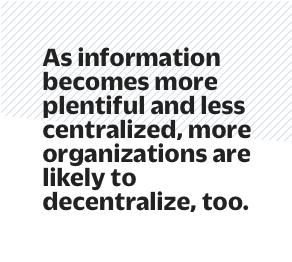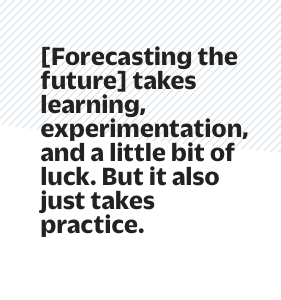Keep asking the right questions, and you’ll be wrong about the future less often than your competitors.
BY FAISAL HOQUE
Remember what 1997 was like? How well?
It was Amazon’s first full fiscal year. Microsoft’s Windows 97 operating system wasn’t there quite yet, and it soon became Windows 98. The internet bubble was on its way, but we couldn’t see it. Y2K was around the corner, too, but few of us were worried yet. Google? Not for another two years. Many companies were still asking themselves if they really needed a web page, and professionals were deciding whether or not to get an email address.
Most of us aren’t futurists, and futurists aren’t oracles. They simply try and make some sense of what’s coming—not hard and fast predictions, just possibilities. The most accurate forecasts we’re able to make are often necessarily broad. What’s always clear is simply that technology will only burrow deeper into our world and organizations, disrupting the way we do things and throwing more threats and opportunities in our way. How it will is more of an open question by comparison.
Still, there are a few ways companies can get better at predicting not just what changes may be around the corner, but how they’ll affect them once those disruptions arrive. Making everyone in your company more effective futurists all starts with asking the right questions. Here are a few of them.
1. WHAT’S OUR PROCESS FOR ASSESSING THE FUTURE?
Your company may not have a formal, codified method for making predictions about the future, but it definitely has a business strategy. And business strategies arise from some set of assumptions about what changes are afoot—accurate or otherwise.
That means that, functionally anyway, your company already makes guesses about the future all the time. What matters is the basis upon which it does, and determining that takes a little self-examination. Start by taking these steps:
- Closely examine your current strategy, right here in the present. How well is your team executing your current plan? What changes are needed today? Consider those execution methods from the perspective of your immediate situation to determine whether changing circumstances is likely to make your organization more or less effective.
- Analyze the impact of your current work of your team, partners, and customers. Where are the most obvious places your results can be improved or revenue increased?
- Evaluate your present capabilities for making those improvements. What assets and resources do you have at your command to try something new?
If this type of assessment sounds a little too present-focused, don’t worry. The assumptions you’re making about the future are embedded directly in the way you’re doing things right now. Most people inside organizations—front-line workers all the way on up to execs—don’t often take time to think through them. Closely reexamining your existing processes can make it easier to see the type of future that your current strategy assumes you’re heading toward.
2. HOW ARE WE READING THE NEWS?
For many of us, innovations in the tech sector tend to be harbingers of change everywhere. Many business leaders’ predictions hinge on an aggregated, subjective sense of what they read in the news. And that’s not a bad place to start. But it’s the inferences we can make about the cutting-edge innovations that truly matter, and making more studied extrapolations takes practice.
Let’s take just one example from this article earlier last year on “smartdust.” That refers to an Internet of Things (IoT) technology that’s based on tiny sensors that can be scattered around, then report back to a network on the environment—noise, light, chemicals, vibration, temperature, and the like. And on the horizon are RFID tags the size of pinheads that could be attached to any product as it makes its way through manufacturing and distribution.

If you work in accounting or for a chemical company, for instance, “smartdust” may seem little more than a sci-fi curiosity, especially since IoT as a whole seems to have hit some serious obstacles lately.
But while the specifics may not directly impact you or your industry, the underlying trend of such an innovation certainly does. What it hints is that we’ll be inundated by a new wave of information as the planet becomes increasingly connected. These are some baseline inferences we can make about how that wave will unfurl, even if individual technologies have wildly different fates:
- Anything that can be digitized will be.
- Anything that can go wireless will.
- Anything that can get smaller will.
- And information will want to move more freely.
These technological transformations will continue to reshape the way the business world is organized. As information becomes more plentiful and less centralized, more organizations are likely to decentralize, too, in order to respond swiftly to it all.
In keeping track of news developments, don’t get overwhelmed by the details, but don’t disregard them either. Just think analysis first and synthesis second: That big new merger that’s getting so much buzz—what does it reveal about the buyer’s priorities and instincts about what’s coming? Or that new technology that’s still years away from hitting the market, the one you keep hearing about in dribs and drabs—what preceding tech is it building upon or threatening to eventually supplant?
Then start connecting those dots: are other companies all making similar bets? Is there another existing technology whose fate might be sealed by that sci-fi–sounding one? Developing this kind of integrated sense of the changes you’re hearing about—however disparately—can help you sharpen your futurist muscles. Just making some time in company meetings (even 15 minutes a week) to talk through some of the latest business and tech news together can bring that habit to your entire team.
3. ARE WE CONSTANTLY TESTING WHAT WE THINK IS WORKING FINE?
When business and technology aren’t integrated, all sorts of bad things can happen. The most common culprit for this lack of integration is untested assumptions about the relationship between the two.
For instance, software designed to automate an existing business process may only speed up an inefficient or ineffective process that isn’t contributing maximum business value—even though you assume that Technology X is automating Process Y. “We have something in place that’s already doing that,” you may imagine. But can you confirm it’s actually working?
It can cut the other way, too. Adapting processes to fit the rules embedded in software may eliminate some activity that differentiates the company and gives it an advantage—at least temporarily, until what you assume about the competition is no longer true. In both of these cases, the outside world is changing more rapidly than ever; it sometimes presents a change before a project is implemented.
But the answer here isn’t to try and turn over every single stone again and again. It’s to keep asking, “What is our purpose?” In other words, why are you here, and what purpose does your company serve? And are you serving that purpose as effectively this month as you were last month? If not, how come? And the answer to that will lead you to those broken links in your organization as soon as they break.
4. HOW ARE WE MANAGING INFORMATION?
Imagine for a moment the building you work in stripped of its walls to reveal the plumbing infrastructure—pipes bringing water into the building and distributing it. Imagine now the various uses to which it’s put—someone washing their hands with hot water on one floor, someone else using cold on another, a water heater providing hot water, a water fountain cooling it, and so on.
Related:
- Conquering The 3 Most Common Types Of Company Crisis
- What This Video Of A Drone Fishing For Tuna Can Teach You About Disruption
- Will Data Science Make Your Business Instincts Irrelevant?
Now imagine the building’s information infrastructure—telephone and internet wiring, boxes for incoming and outgoing snail mail, cable television connections, wireless routers, and so on—taking information from the outside or inside and distributing it.
Then picture the users of this information. An executive studies a computer dashboard of operational data, an employee surfs the web, an administrative assistant sifts through the paper mail, a committee meets and hears a report, email flows endlessly, operational plans are printed and bound and put on a shelf, and on and on.
New ideas float along these “flows” of information. And a leader’s task is twofold: Ensure that you have the right flows in place, and create “filters” that capture the most valuable ideas while discarding the stuff that isn’t useful or relevant.
How do you set up those filters? In general, information can be managed in three ways. One is through organizational structures, such as decision-making groups. Another is in processes—who hands off what information to whom. The other is through automation—technology that gathers and presents data, such as CRM data from a website.

But while it’s vital to view your organization as an information collector, processor, and distributor all at once, it’s just as important to see and act upon something new in all that information. The futurist Amy Webb outlines a handful of questions that anybody can ask themselves in order to distinguish a genuine trend from something that’s merely “trending”—to tell the proverbial signal from the noise. To paraphrase three of her criteria (although there’s more than that):
- A trend is timely but persists over time.
- A trend evolves even while it’s still emerging.
- The dots connect more and more as the trend goes mainstream.
We can’t predict the future. But we can make sure the next generation of leaders is prepared to live it, make sense of it, and orchestrate its upheavals as strategically as possible. That takes learning, experimentation, and a little bit of luck.
But it also just takes practice. And as long as you can get everyone inside your organization to keep asking the right questions, you’re likely to be wrong about the future less often than your competitors are.
[Photo: Bettmann/Contributor/Getty Images]
Original Article @FastCompany.
Serial entrepreneur Faisal Hoque is the founder of Shadoka, which enables entrepreneurship, growth, and social impact. He is the author of Everything Connects: How to Transform and Lead in the Age of Creativity, Innovation, and Sustainability (McGraw-Hill) and other books. Use the Everything Connects leadership app for free.
Copyright (c) 2016 by Faisal Hoque. All rights reserved.
















